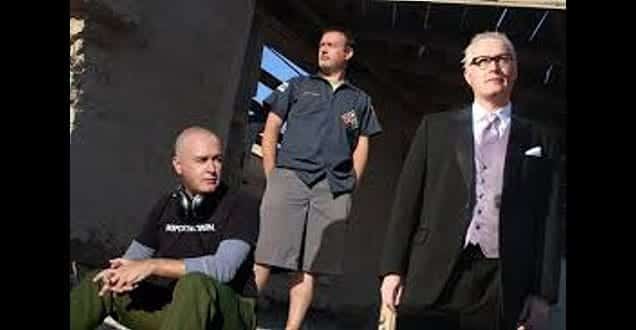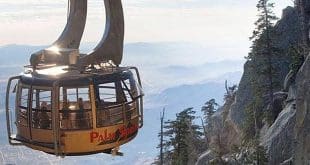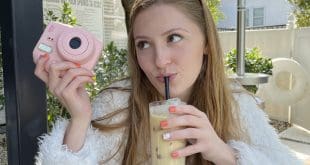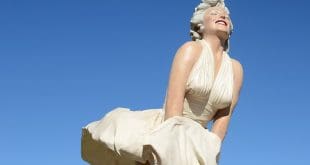Travis Hiner, also known as Suboken, was born in Longview, Washington, and moved to Southern California as a child. A 1990 graduate of Palm Springs High School, he then moved to San Francisco to obtain a film arts degree from the Academy of Art University. He now lives and creates in Greater Palm Springs. His solo exhibit, “The Suboken Project: Presenting…” will be on exhibit at the Palm Desert Community Art Gallery from Nov. 21 – Jan. 31, featuring two of Hiner’s conceptual collections: “The Cartographer’s Dilemma” and “In A Place: Series Two.”
KB: Travis—or should I call you, Suboken?—I’m fascinated by the conceptual lineage of your art. I understand that your dual studies and engagement with film and philosophy brought you to your current explorations/artworks. Can you comment on this?
Travis Hiner: Travis is fine. Suboken is a nickname that I adopted while developing my career in music.>Film is a great modern medium to explore the big “what if?” questions philosophy introduces. Philosophy often uses thought experiments: analogies that help contextualize concepts and dilemmas that might otherwise be difficult to wrap our heads around. Movies are perfectly suited to present analogies in ways that are not only entertaining, but can connect with us emotionally.Joseph Campbell spoke of how important mythology and storytelling are to our social development as we mature into adulthood. When I focused my studies toward understanding how this concept works within us, I became equally fascinated in how the use of analogies and language shape our understanding of the world. This in turn lead me to study philosophy, fueling a newfound ambition to learn how to piece it all together.
KB: In addition to your background in film, you worked for a time as an Assistant Art Director as well as a Visual Effects Makeup Artist. How did these experiences influence your work?
TH: Both career experiences planted seeds of creative collaboration. It was an uncomfortable realization for me to face my ownership and protective tendencies with regard to my creativity. Allowing myself to work in a group of creative people in service of a project with a greater vision than any single contribution was one of the healthiest creative experiences I’ve ever had. Participation and creative input can be drastically different within a team of collaborators, yet can still remain in balance with one another.
On a technical level, makeup effects for film influenced my focus to mask or hide my hand in my craft (not that I don’t appreciate the brushstrokes present in an exquisite painting). The success of makeup effects for film is often contingent on its realism. With the work I’m currently excited to produce, I’m keen on diminishing my personal presence from the final work. Makeup effects for live theater pushed my creative development in terms of time management. In theater, an actor doesn’t have very long to sit in the makeup chair—if sitting is even an option during a quick change. In such environments, the key is for the artist to quickly assess what makeup changes need to be applied and commit to making them happen with very little time to experiment. Makeup for theater also taught me to embrace an ephemeral aspect to creativity. The craftwork is only seen for a moment, and is forever gone as soon as the actor washes her face clean. Only the experience for those who shared in that moment remains.
KB: I’m interested in your statement that the study of philosophy gave you the voice and content to address through your artwork. What’s your biggest concern or fascination in this regard?
TH: During college I worked part time as a barista, and one of our cafe’s regular customers asked me what I was studying. When I answered that I was pursuing two majors: art and philosophy, he jokingly replied that both majors were terrible in terms of landing a lucrative career.
Looking back on my younger self, my assumption about fine art was that it had to make a statement or claim. Back then, I didn’t have a particular point of view that I felt added anything new to the conversation. What studying philosophy did was reveal an unease about knowledge and understanding. When I first started exploring philosophy, I remember losing a lot of sleep throughout the semesters. My insomnia wasn’t as much a result of cramming for exams as it was about seeking answers to the questions I was introduced to through philosophy. Philosophical answers are elusive, especially if I don’t have the clearest view of the question. Creating art allows me to meditate on the question, using the forms and colors to symbolize different aspects of whichever topic or theme I am exploring.
One particular philosophical concept that continues to fascinate me is the issue of perception, both physical and mental. The only experience I can access is the one locked up in my head. Recognizing how precious my experience is led me to realize how vulnerable my perception is to the filters of culture, language, and physical health.
KB: Have you read Malcolm Gladwell? He’s also interested in how our sensory input—or preconceived notions!—either limit or overtly inform our perceptions of reality. Has he or any other author (I believe you mentioned Borges) influenced your work, and if so, in what way?
TH: I only know of Malcolm Gladwell through his TED Talks, but I’m certainly intrigued by what he has to say. Julian Baggini is a contemporary writer I often return to for inspiration. Baggini’s books are perfect launching pads for exploring the vast facets of the universe of philosophy. Another writer I’m currently leaning on with regard to my exhibit, The Cartographer’s Dilemma, is Jean Baudrillard. Baudrillard is often labeled as a postmodern philosopher. In his book Simulacra and Simulation, he uses a Jorge Luis Borges fable as an analogy to illustrate his commentary on humankind’s current postmodern condition.
The Borges fable describes an empire that has created a map so perfect that it shares a direct 1:1 scale relationship with the land within the empire’s borders. After a long period of time, this map eventually degrades, leaving only shreds to be found in remote regions of the desert. In line with the devices of postmodern critique, Baudrillard flips the circumstances and posits that in our postmodern condition, it is the map—or rather symbol of what was the real world—that’s taken primacy. The citizens of the empire are unaware that actual world the map referred to has rotted away, leaving only shreds that cling to the map.The interpretation of Baudrillard’s analogy is that the symbols and icons people cherish have become more important than the ideas and subjects they were intended to reference. For me, the question becomes, if references can so easily distort my experience of the natural world, what steps do I take to diminish their effect?
KB: In addition to your studies, you must have formed some additional theories, metrics and ideas through the act of creating your work. In your opinion, how much of reality is “in our own minds,” as opposed to objectively present in the world?
TH: For me, the whole dilemma is that it’s impossible to identify where the line between subjective and objective reality lies—assuming such a line even exist. When examined, our sensory organs are incredibly limited in how they inform us about the physical world. And then there’s the whole issue of how our mind layers additional filters over our perception of the physical world. So is there a point where we can identify what is and isn’t objective reality? It seems every position taken on the subject can be argued both for and against. Yet, is the obscurity of the answer due to our language getting in the way? What I’m exploring is whether or not visual art can more clearly present this issue without relying on the use of words.
KB: What is it to perceive the world?
TH: That is the question, isn’t it? How do we define perception? What do we regard as real? I know I’ve tossed around the term “reality” when summarizing my art, but that question is central to a number of projects I’m working on. Because I don’t have the answer, I keep exploring the question through my creativity. However, that question needn’t be a debilitating one. I still greatly enjoy experiencing the world, even if I don’t fully understand what it is. Creating visual art and music are stimulating ways to share my experiences with others.Here’s a thought experiment that illustrates this issue regarding perception in a more concise way: Three volunteers are asked to come up on stage and verify the temperature of a bucket of water. Two of the volunteers are asked to wait in separate rooms offstage while Volunteer A tests the water temperature. Volunteer A puts her hand in the water and claims the water is room temperature. Volunteer B is then escorted from her room in which the climate was considerably colder than the climate on stage. Upon putting her hand in the water, volunteer B claims the water is warm. Then volunteer C, who has been waiting in a room where the temperature was much warmer than the stage’s temperature is finally brought on stage to test the water in the bucket, to which she replies that the water is cool. Now, we can place a thermometer in the water and read what the gauge reports the water temperature to be, say 78°. But that doesn’t say much about the temperature we experience the water to be.
KB: Like many artists, you’ve hopped around a bit: Washington, Southern California, Northern California, and now you make your home in Palm Desert. Does place or landscape have a voice in your work?
TH: Absolutely it does. Not only in a literal sense, but in a cultural sense as well. During the brief intervals I spent living in Washington state, I had access to explore the forests of the Pacific Northwest. Experiencing those landscapes formed by the volcanoes of the Cascade Mountain Range left a strong impression on me that remains to this day.When I moved to San Francisco in my twenties, I was eager to explore the natural settings along the California coast, from the Marin Headlands to Big Sur. However, the city is relentless in offering exciting cultural experiences, and it wasn’t practical to take frequent long drives up and down the coast. Yet, the theme behind the In A Place project was born from living in San Francisco. Living in the densely populated city, I was hungry for any chance to connect with nature.
Something I appreciated about living in San Francisco was how relatively easy it was to get by without owning a car. The majority of my travels throughout the city were either on foot or bicycle. It was during my treks across the city that I began to take notice of the small instances where nature persisted in sharing space within the city environments. I had already started to capture images of miniature picnic tables in scaled settings. But it was my desire to keep a naturalist perspective fresh in my mind that lead me to explore this specific concept through the In A Place images.Initially, moving to the Coachella Valley with its abundance of natural settings seemed like a perfect match for In A Place. However, it became more of a challenge with regard to the thematic focus behind the project—recognizing the diverse scaled landscapes just outside our doorsteps. I spent a year closing in on locations among the sprawling development of the Palm Springs area. After slowing my pace down, taking the time to look, those unique miniature settings were absolutely present everywhere I searched.
KB: Give us a brief synopsis of your two exhibits:“The Cartographer’s Dilemma” and “In A Place: Series Two.”
TH: The Cartographer’s Dilemma is the first in a series of themed wall relief sculptures. The work is comprised of a set of meticulously hand-sculpted clay dowels that form a three-dimensional veil of form and color in front of a heavily textured sand background. However, the dowels themselves are also obscured by a transparent two-dimensional plexiglass filter of form and color that attempts to mimic and enhance the dowel layer beneath it.In A Place: Series Two is part of a larger collection of photos I’ve been taking over the past six years. The photos feature an assortment of diverse hand-sculpted miniature picnic tables placed in commonly overlooked neighborhood environments. The composition of each image is framed so that the natural surroundings of the picnic table appear to be new and exotic locales. The charm of the picnic table placed in these landscapes works to make the content and context of In A Place accessible to everyone.
KB: Can you tell me a bit about your creative process?
TH: My creative process is never uniform or predictable, which can be frustrating. That speaks to both the inspiration behind a concept as well as the medium(s) used to express that concept.All my life I’ve been a daydreamer. During this continued process of developing my artistic voice, ideas inform questions, which in turn inform new ideas, and so forth. With regard to my art, when the feedback of this process begins to present a more refined concept, I usually start to build with my hands. This often involves creative writing (exploring the analytical), writing music (exploring the emotion), and in recent years, building with LEGO (exploring the spacial presence). These creative exercises allow me to develop the motifs and analogies that evolve into the final work.
KB: What can people expect when they go to view your exhibit? Or, put another way, what do you hope that they experience?
TH: It goes without saying that I simply hope the artwork resonates with the viewer. My work is about offering the viewer a visual framework from which she can explore her own ideas, and no single interpretation is less valid than any other.
KB: Travis Hiner, what is it that you most love about the Palm Springs area?
TH: Being close to loved ones is what brought me here. Having access to so many diverse natural settings and environments is one of the things I appreciate the most about the Palm Springs area.Please click here for information on Travis’s current exhibition.For additional information on Travis Hiner and The Suboken Project, please visit his official website and artist blog.






